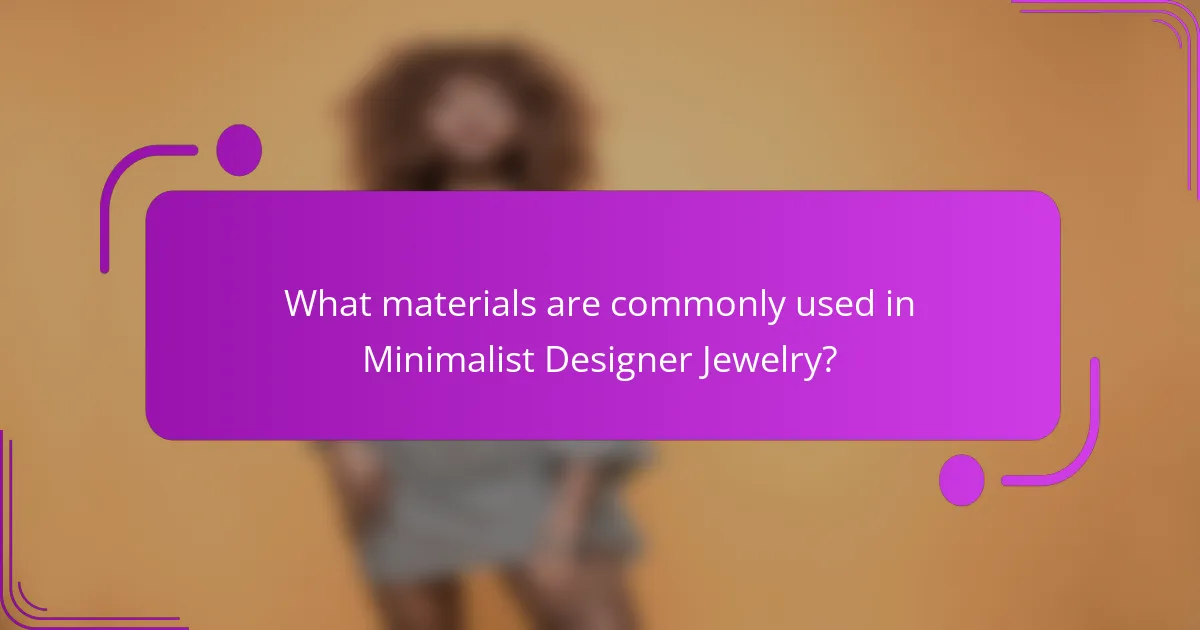Minimalist designer jewelry is characterized by simplicity and understated elegance, featuring clean lines and geometric shapes that highlight the beauty of materials without excessive embellishments. Common materials used include precious metals like gold and silver, along with stainless steel and subtle gemstones. This style emphasizes wearability and functionality, creating versatile pieces suitable for everyday use while appealing to contemporary aesthetics. The focus on lightweight designs and timeless elegance ensures that minimalist jewelry integrates seamlessly into various lifestyles, catering to consumer preferences for comfort and practicality. The article explores the design philosophy, material choices, and the significance of wearability in minimalist designer jewelry.

What is Minimalist Designer Jewelry?
Minimalist designer jewelry is a style characterized by simplicity and understated elegance. This type of jewelry often features clean lines and geometric shapes. It emphasizes the beauty of materials without excessive embellishments. Common materials include precious metals, such as gold and silver, often combined with gemstones in subtle ways. Minimalist designer jewelry aims to create versatile pieces suitable for various occasions. The design philosophy focuses on functionality and wearability, allowing pieces to be worn daily. This approach resonates with contemporary aesthetics, appealing to those who appreciate refined simplicity.
How is Minimalist Designer Jewelry defined?
Minimalist Designer Jewelry is defined as jewelry that emphasizes simplicity and clean lines. This design approach often features geometric shapes and understated elegance. The focus is on form and function rather than ornate embellishments. Materials used are typically high-quality and may include metals like gold or silver. The aesthetic is modern and timeless, appealing to those who appreciate subtlety. Minimalist Designer Jewelry is often versatile, suitable for various occasions and styles. This approach is rooted in the philosophy that “less is more,” promoting a refined and sophisticated look.
What are the key characteristics of Minimalist Designer Jewelry?
Minimalist designer jewelry is characterized by simplicity, clean lines, and understated elegance. The designs often feature geometric shapes and a limited color palette. Materials used typically include high-quality metals such as gold, silver, and stainless steel. The pieces are often lightweight and easy to wear, enhancing comfort. Minimalist jewelry emphasizes subtlety, allowing for versatility in styling. Many designs focus on negative space, creating a sense of balance. This style often avoids excessive embellishments, prioritizing form over decoration. Overall, minimalist designer jewelry embodies a modern aesthetic that appeals to those who appreciate refined simplicity.
How does Minimalist Designer Jewelry differ from other styles?
Minimalist Designer Jewelry is characterized by its simplicity and understated elegance. Unlike other styles that may feature intricate designs or bold embellishments, minimalist jewelry focuses on clean lines and geometric shapes. This approach emphasizes the beauty of the materials used, often showcasing high-quality metals and stones without excessive adornment. Minimalist pieces are designed to be versatile and timeless, allowing for easy integration into various outfits. The philosophy behind this style prioritizes functionality and wearability, making it suitable for everyday use. Research indicates that minimalist design can evoke feelings of calm and clarity, aligning with contemporary trends towards simplicity in fashion.
Why is Minimalism significant in jewelry design?
Minimalism is significant in jewelry design because it emphasizes simplicity and elegance. This design philosophy reduces elements to their essential forms. It allows the inherent beauty of materials to shine through. Minimalist jewelry often features clean lines and geometric shapes. This approach appeals to modern aesthetics and personal expression. Furthermore, minimalist designs are versatile and can complement various styles. They often prioritize quality over quantity, focusing on craftsmanship. The trend has gained popularity in contemporary fashion, reflecting a broader cultural shift towards minimalism.
What cultural influences shape the minimalist design philosophy?
Minimalist design philosophy is shaped by various cultural influences, including Japanese aesthetics and Scandinavian design principles. Japanese culture emphasizes simplicity and the beauty of natural materials, as seen in the concept of “wabi-sabi,” which values imperfection and transience. Scandinavian design, rooted in functionality, promotes clean lines and minimal ornamentation, reflecting a lifestyle that prioritizes practicality and comfort. Both cultures advocate for a connection with nature, encouraging the use of organic forms and sustainable materials. These influences foster a design ethos that celebrates restraint, clarity, and the essence of objects, leading to the minimalist approach in various design fields, including jewelry.
How does minimalism affect consumer choices in jewelry?
Minimalism significantly influences consumer choices in jewelry by promoting simplicity and functionality. Consumers often prefer pieces that feature clean lines and understated elegance. This aesthetic aligns with a growing desire for sustainable and timeless designs. Minimalist jewelry often uses fewer materials, reducing waste and environmental impact. Research indicates that minimalist designs resonate with consumers seeking authenticity and personal expression. A study published in the Journal of Consumer Research highlights that minimalist products can enhance perceived value. As a result, consumers gravitate towards brands that embody minimalist principles in their collections.
What are the core principles of minimalist jewelry design?
Minimalist jewelry design focuses on simplicity, functionality, and elegance. The core principles include clean lines, limited embellishments, and a focus on form. Minimalist pieces often use geometric shapes and asymmetry. The design emphasizes balance and proportion, enhancing the wearer’s natural beauty. High-quality materials are prioritized, often featuring metals like gold, silver, or platinum. Color palettes are typically neutral, allowing for versatility in wear. The intention is to create timeless pieces that withstand trends. This approach fosters a sense of calm and clarity in personal style.
How do simplicity and functionality play a role in design?
Simplicity and functionality are essential in design as they enhance usability and aesthetic appeal. Simplicity reduces clutter, allowing users to focus on the core features of a design. This approach often leads to more intuitive interactions. Functionality ensures that the design serves its intended purpose effectively. In minimalist jewelry, for example, simplicity often translates to clean lines and unobtrusive forms. This not only makes the pieces visually appealing but also comfortable to wear. Research indicates that designs with high simplicity and functionality lead to increased user satisfaction. A study published in the Journal of Design Research found that users prefer products that are easy to understand and use. This reinforces the idea that simplicity and functionality are critical for successful design.
What aesthetic values are prioritized in minimalist design?
Minimalist design prioritizes simplicity, functionality, and elegance. These aesthetic values emphasize clean lines and uncluttered spaces. The focus is on essential elements, removing excess. This approach enhances the beauty of the object or space. Minimalist design often uses neutral colors and natural materials. It promotes a sense of harmony and balance. Each piece is thoughtfully curated to convey meaning. This design philosophy encourages a deeper appreciation for craftsmanship and detail.

What materials are commonly used in Minimalist Designer Jewelry?
Minimalist designer jewelry commonly uses materials like gold, silver, stainless steel, and gemstones. Gold is favored for its timeless appeal and durability. Silver is popular due to its versatility and affordability. Stainless steel offers a modern, sleek appearance and is resistant to tarnish. Gemstones, when used, are often chosen for their simplicity and elegance. These materials align with minimalist design principles, emphasizing clean lines and understated beauty.
How do material choices impact the overall design?
Material choices significantly influence the overall design of minimalist designer jewelry. The selection of materials affects aesthetics, durability, and functionality. For example, metals like gold and silver offer a classic appeal. They also provide strength and longevity. In contrast, materials such as resin or wood can introduce unique textures and colors. These choices can enhance visual interest while maintaining a minimalist approach. Additionally, lightweight materials improve wearability for daily use. The combination of materials can create a balance between elegance and comfort. Ultimately, the right material enhances the design’s intention and user experience.
What are the most popular materials for minimalist jewelry?
The most popular materials for minimalist jewelry include gold, silver, and stainless steel. Gold is favored for its timeless appeal and durability. Silver is appreciated for its affordability and versatility in design. Stainless steel offers strength and a modern aesthetic. Other materials such as titanium and gemstones are also used, but less frequently. The choice of material impacts the overall look and feel of the jewelry. Minimalist designs often emphasize simplicity and quality in these materials.
How do sustainable materials influence minimalist jewelry trends?
Sustainable materials significantly influence minimalist jewelry trends by promoting eco-conscious design. These materials, such as recycled metals and ethically sourced gemstones, align with the minimalist ethos of simplicity and intentionality. Designers increasingly prioritize sustainability, leading to innovative designs that are both aesthetic and responsible. The use of sustainable materials often results in unique textures and finishes, enhancing the appeal of minimalist pieces. Consumer demand for eco-friendly options has grown, driving brands to adopt sustainable practices. Research indicates that 66% of consumers are willing to pay more for sustainable products. This shift has led to a broader acceptance of minimalist jewelry as a sustainable fashion choice.
What are the benefits of using specific materials in minimalist designs?
Using specific materials in minimalist designs enhances aesthetic appeal and functionality. Materials like metal, wood, and glass provide a clean, modern look. They emphasize simplicity and elegance, which are core principles of minimalist design. For example, stainless steel is durable and resistant to tarnish, making it ideal for long-lasting pieces. Wood offers warmth and a unique texture, adding character without overwhelming the design. Additionally, glass can create a sense of lightness and transparency. These materials allow designers to focus on form and function while maintaining an uncluttered aesthetic. Ultimately, the choice of materials directly influences the overall impact and wearability of minimalist jewelry.
How do different materials contribute to the durability of jewelry?
Different materials significantly impact the durability of jewelry. Metals like gold and platinum resist tarnish and corrosion, ensuring longevity. Stainless steel is also durable, offering resistance to scratches and dents. Gemstones contribute durability through hardness; for example, diamonds are rated 10 on the Mohs scale. Organic materials, such as pearls, require careful handling to prevent damage. Each material’s unique properties dictate its resilience to wear and environmental factors. Understanding these characteristics helps in selecting jewelry that maintains its beauty over time.
What role does texture play in minimalist jewelry materials?
Texture in minimalist jewelry materials enhances visual interest and tactile experience. It creates depth without overwhelming the simplicity of the design. Different textures, such as matte, polished, or hammered, can evoke various emotional responses. For instance, a matte finish may convey subtlety, while a polished surface can suggest elegance. Texture also plays a crucial role in light reflection, influencing how pieces interact with their environment. This interaction can elevate the piece’s overall aesthetic without adding complexity. Consequently, texture is essential in minimalist jewelry, balancing simplicity with sophistication.

How does wearability factor into Minimalist Designer Jewelry?
Wearability is a crucial aspect of Minimalist Designer Jewelry. It emphasizes comfort and practicality alongside aesthetic appeal. Minimalist designs often feature lightweight materials that enhance daily wear. These pieces are crafted to be versatile, easily pairing with various outfits. The simplicity of the designs allows for effortless integration into a wearer’s lifestyle. Additionally, the focus on clean lines and subtle elegance ensures that the jewelry remains timeless. Research indicates that consumers prioritize wearability when selecting jewelry, influencing design choices significantly. Brands that prioritize wearability often see higher customer satisfaction and repeat purchases.
What makes minimalist jewelry versatile for different occasions?
Minimalist jewelry is versatile for different occasions due to its simple and elegant design. This style allows it to complement a wide range of outfits. Minimalist pieces often feature neutral colors and clean lines. This makes them suitable for both casual and formal settings. The understated nature of minimalist jewelry prevents it from overwhelming an outfit. It can be layered or worn alone, offering flexibility in styling. Research shows that minimalist designs are often preferred for their timeless appeal. This adaptability ensures that they remain fashionable across various events and trends.
How can minimalist jewelry be styled for casual versus formal wear?
Minimalist jewelry can be styled for casual wear by pairing simple pieces with everyday outfits. A delicate necklace or stud earrings complement a t-shirt and jeans. For a more polished casual look, layering a few minimalist bracelets adds interest without overwhelming the outfit.
For formal wear, minimalist jewelry enhances elegance without distraction. A sleek pendant or understated hoop earrings can elevate a little black dress. Choosing pieces with subtle shine, like gold or silver, adds sophistication.
Minimalist designs focus on clean lines and simplicity. This versatility allows them to transition seamlessly between casual and formal settings.
What considerations should be made for comfort and fit?
Comfort and fit in minimalist designer jewelry are crucial for an enjoyable wearing experience. Proper sizing ensures that pieces do not pinch or slide off. Materials should be lightweight to prevent discomfort during extended wear. Smooth edges and finishes minimize irritation on the skin. Adjustable features can enhance fit for various body types. The design should allow for natural movement without restriction. These considerations contribute to overall satisfaction and usability of the jewelry.
Why is wearability important in the context of minimalist design?
Wearability is crucial in minimalist design because it enhances user experience and functionality. Minimalist design prioritizes simplicity, often resulting in pieces that are lightweight and comfortable. This approach allows for easy integration into daily wear. When jewelry is wearable, it becomes more appealing to consumers. Studies show that comfort significantly influences purchasing decisions. For instance, a survey found that 75% of consumers prefer jewelry that they can wear all day without discomfort. Therefore, wearability directly impacts the success of minimalist designs in the jewelry market.
How does wearability enhance the value of minimalist jewelry?
Wearability enhances the value of minimalist jewelry by ensuring it can be comfortably worn in various settings. This functionality increases its appeal to consumers seeking versatile accessories. Minimalist designs often prioritize simplicity, which allows for easy pairing with different outfits. The lightweight materials used in such jewelry contribute to comfort during extended wear. Additionally, wearability fosters a sense of connection between the wearer and the piece. This emotional bond can elevate the perceived value of the jewelry. Research indicates that consumers are willing to pay more for items they can wear frequently and comfortably. Therefore, wearability is a key factor in the overall value of minimalist jewelry.
What feedback do consumers provide regarding wearability in minimalist designs?
Consumers often report that minimalist designs enhance wearability due to their lightweight nature. Many appreciate the simplicity that allows for versatile styling. Feedback indicates that minimalist pieces are comfortable for all-day wear. Some consumers highlight the ease of pairing these designs with various outfits. Durability is another aspect frequently mentioned, as minimalist jewelry tends to resist damage. Additionally, users note that the lack of excessive embellishments contributes to a more understated elegance. Overall, the consensus is that minimalist designs provide a balance of comfort and style.
What tips can enhance the experience of wearing minimalist jewelry?
To enhance the experience of wearing minimalist jewelry, choose pieces that complement your personal style. Select jewelry that aligns with your wardrobe for a cohesive look. Opt for high-quality materials to ensure durability and comfort. Layering minimalist pieces can create a unique statement while maintaining simplicity. Consider the occasion when selecting jewelry to match the formality of your outfit. Regularly clean your jewelry to maintain its shine and appearance. Store pieces properly to prevent tangling and damage. Finally, embrace the subtlety of minimalist designs to appreciate their elegance.
The main entity of the article is Minimalist Designer Jewelry, a style that emphasizes simplicity, clean lines, and understated elegance. The article explores the design philosophy behind minimalist jewelry, including its key characteristics, cultural influences, and the significance of minimalism in contemporary fashion. It also discusses material choices, highlighting common materials like gold, silver, and stainless steel, and their impact on durability and aesthetics. Additionally, the article addresses the importance of wearability and versatility in minimalist designs, providing insights into how these factors enhance consumer appeal and overall value.